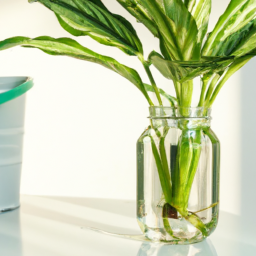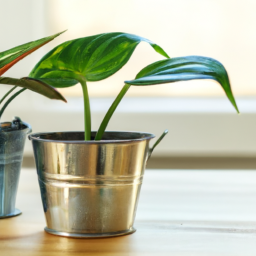
Have you ever wondered how indoor plants can actually help purify the air in your home or office space? In this blog post, we will explore the fascinating topic of “How Do Indoor Plants Purify Air” and uncover the science behind this natural air purification process. Many of us may already know that plants produce oxygen through photosynthesis, but did you know that they can also filter out harmful toxins and pollutants from the air we breathe? Let’s dive into the world of indoor plants and discover the incredible benefits they provide for our indoor air quality.
Benefits of Indoor Plants for Air Purification
Introduction
Indoor plants are not just decorative elements in our homes and offices; they also play a crucial role in purifying the air we breathe. Plants have the amazing ability to absorb harmful toxins and pollutants from the air, making it cleaner and healthier for us to inhale. In this article, we will explore the various benefits of indoor plants for air purification and how you can maximize their effectiveness in your indoor spaces.
How Indoor Plants Purify Air
Plants are nature’s air purifiers, using a process called photosynthesis to convert carbon dioxide into oxygen. But did you know that they can also remove harmful chemicals and toxins from the air? Indoor plants have been shown to absorb pollutants such as formaldehyde, benzene, and trichloroethylene, which are commonly found in indoor environments due to cleaning products, furniture, and building materials.
When plants absorb these pollutants through their leaves and roots, they break them down into harmless byproducts that are then released back into the air. This natural process helps to improve indoor air quality and reduce the risk of respiratory problems and other health issues associated with poor air quality. In addition, plants release moisture into the air through a process called transpiration, which can help to increase humidity levels and reduce the presence of airborne allergens.
In a study conducted by NASA, researchers found that certain indoor plants are particularly effective at removing toxins from the air. Some of the best air-purifying plants include the spider plant, peace lily, snake plant, and pothos. These plants are not only easy to care for but also have the ability to filter out a wide range of pollutants, making them ideal choices for improving indoor air quality.
Tips for Maximizing Air Purification with Indoor Plants
If you want to make the most of your indoor plants for air purification, there are a few key tips to keep in mind. First, make sure to choose the right plants for your space based on their air-purifying abilities and your own preferences. Consider placing multiple plants throughout your home or office to maximize their impact on air quality.
Next, pay attention to the care and maintenance of your plants to ensure they remain healthy and effective at purifying the air. This includes regular watering, proper lighting, and occasional pruning to remove dead leaves and promote new growth. You can also supplement your plants’ natural air-purifying abilities by using a humidifier or air purifier in conjunction with your indoor plants.
Lastly, consider the placement of your plants to optimize their air-purifying benefits. Place plants near windows or doors to maximize air circulation and exposure to natural light. You can also group plants together in clusters to create a mini indoor garden that not only looks beautiful but also helps to purify the air more effectively.
In conclusion, indoor plants offer a natural and cost-effective way to improve indoor air quality and promote a healthier living environment. By understanding how plants purify the air and following these tips for maximizing their air-purifying benefits, you can enjoy cleaner and fresher air in your home or office. So go ahead and bring some greenery into your indoor spaces to breathe easier and live healthier.

Best Indoor Plants for Improving Air Quality
As an expert in indoor plants and air purification, I am here to guide you on the best indoor plants that can help improve the air quality in your home. Indoor plants are not only aesthetically pleasing but also play a crucial role in purifying the air by removing toxins and pollutants. By incorporating these plants into your living space, you can create a healthier environment for you and your family.
Spider Plant
The Spider Plant, also known as Chlorophytum comosum, is a popular choice for indoor spaces due to its easy maintenance and air-purifying properties. This plant is effective in removing formaldehyde, xylene, and toluene from the air, making it an excellent choice for improving indoor air quality. The Spider Plant is also safe for pets, making it a versatile option for any household.
To care for your Spider Plant, place it in indirect sunlight and water it regularly, allowing the soil to dry out between waterings. You can also propagate the Spider Plant by planting its baby spiderettes in a separate pot, creating a beautiful display of cascading greenery in your home.
In addition to its air-purifying benefits, the Spider Plant is also known for its ability to reduce stress and improve mood, making it a perfect addition to any indoor space where relaxation and well-being are a priority.
Peace Lily
The Peace Lily, or Spathiphyllum, is another excellent choice for improving indoor air quality. This plant is known for its ability to remove harmful toxins such as ammonia, benzene, and formaldehyde from the air, making it a powerful air purifier for your home. The Peace Lily also helps to increase humidity levels, creating a more comfortable and healthier environment for you and your family.
To care for your Peace Lily, place it in low to medium light and water it regularly, allowing the soil to dry out slightly between waterings. The Peace Lily is a low-maintenance plant that thrives in indoor environments, making it a perfect choice for beginners or those with busy schedules.
In addition to its air-purifying properties, the Peace Lily is also known for its beautiful white flowers and elegant appearance, adding a touch of sophistication to any room in your home. By incorporating a Peace Lily into your indoor space, you can enjoy cleaner air and a more inviting atmosphere for yourself and your loved ones.
Snake Plant
The Snake Plant, also known as Sansevieria, is a hardy and resilient plant that is perfect for improving indoor air quality. This plant is effective in removing toxins such as formaldehyde, benzene, and trichloroethylene from the air, making it an excellent choice for purifying the air in your home. The Snake Plant is also known for its ability to produce oxygen at night, making it a great option for bedrooms or other areas where air quality is a concern.
To care for your Snake Plant, place it in indirect sunlight and water it sparingly, allowing the soil to dry out completely between waterings. The Snake Plant is a low-maintenance plant that thrives in a variety of indoor conditions, making it a versatile option for any home.
In addition to its air-purifying benefits, the Snake Plant is also known for its unique appearance and architectural shape, adding a modern touch to any room in your home. By incorporating a Snake Plant into your indoor space, you can enjoy cleaner air and a more stylish environment for yourself and your family.

Tips for Maintaining Indoor Plants to Purify Air
Choosing the Right Plants
When it comes to purifying the air in your home, not all indoor plants are created equal. Some plants are more effective at removing toxins and pollutants from the air than others. To ensure that your indoor plants are doing their job effectively, it’s important to choose the right plants for your space.
Plants such as spider plants, peace lilies, and snake plants are known for their air-purifying abilities. These plants are not only easy to care for but also highly effective at removing harmful chemicals like formaldehyde, benzene, and trichloroethylene from the air.
When selecting indoor plants for air purification, consider the size of your space, the amount of natural light available, and your level of gardening experience. Choose plants that are well-suited to your environment to ensure that they thrive and effectively purify the air in your home.
Proper Watering and Lighting
One of the most important factors in maintaining indoor plants for air purification is proper watering and lighting. Indoor plants require the right amount of water and sunlight to thrive and effectively remove toxins from the air.
Overwatering or underwatering can be detrimental to the health of your indoor plants. Make sure to water your plants according to their specific needs and monitor the soil moisture regularly. Additionally, place your plants in a location where they can receive adequate sunlight to support their growth and air-purifying abilities.
If your indoor plants are not receiving enough natural light, consider supplementing with artificial grow lights to ensure that they have the energy they need to purify the air in your home. Proper watering and lighting are essential for maintaining healthy indoor plants that effectively clean the air.
Regular Maintenance and Cleaning
In order for indoor plants to continue purifying the air in your home, they require regular maintenance and cleaning. Dust and debris can accumulate on the leaves of plants, hindering their ability to photosynthesize and remove toxins from the air.
Regularly dusting the leaves of your indoor plants with a soft cloth or sponge can help to keep them clean and functioning optimally. Additionally, inspect your plants regularly for signs of pests or disease, and take appropriate action to address any issues that may arise.
Pruning dead or yellowing leaves, repotting plants as needed, and fertilizing them with a balanced plant food can also help to keep your indoor plants healthy and thriving. By maintaining and cleaning your indoor plants regularly, you can ensure that they continue to purify the air in your home effectively.
Let’s bring it all home
Indoor plants are not only a beautiful addition to your home decor, but they also play a crucial role in purifying the air we breathe. Plants have the amazing ability to absorb harmful toxins and pollutants from the air through a process called phytoremediation. This process involves plants taking in pollutants like formaldehyde, benzene, and trichloroethylene through their leaves and roots, and converting them into harmless byproducts. By having indoor plants in your home, you can significantly improve the air quality and create a healthier living environment for you and your family.
Some of the best air-purifying plants include spider plants, peace lilies, snake plants, and pothos. These plants are not only easy to care for but also highly effective at removing toxins from the air. Additionally, plants release oxygen during photosynthesis, which can help increase oxygen levels in your home and boost your overall well-being. So, next time you’re looking to add some greenery to your space, consider choosing plants that not only look good but also work hard to keep the air clean and fresh.
FAQ Compilation:
Q1. Do indoor plants really purify the air?
A1. Yes, indoor plants have the ability to purify the air by absorbing harmful toxins and releasing oxygen through the process of photosynthesis.
Q2. How do indoor plants purify the air?
A2. Indoor plants purify the air by absorbing pollutants such as formaldehyde, benzene, and trichloroethylene through their leaves and roots, converting them into nutrients for growth.
Q3. Which indoor plants are best for purifying air?
A3. Some of the best indoor plants for purifying air include the snake plant, spider plant, peace lily, pothos, and rubber plant, among others.
Q4. How many indoor plants do I need to purify the air in my home?
A4. The number of indoor plants needed to effectively purify the air in your home depends on factors such as room size, plant size, and the types of pollutants present. In general, having 1-2 plants per 100 square feet of space is recommended.
Q5. How do I care for indoor plants to ensure they continue purifying the air?
A5. To ensure your indoor plants continue to purify the air, make sure to water them regularly, provide adequate sunlight, dust their leaves occasionally, and monitor for signs of pests or disease.
Dr. Olivia Green is a botanist with over two decades of experience in indoor plant cultivation. She holds a Ph.D. in Plant Biology and has dedicated her career to researching plant behavior in controlled environments. Dr. Green is passionate about helping plant enthusiasts master the art of indoor gardening through her extensive knowledge and practical insights.


